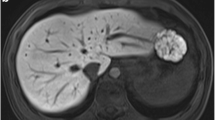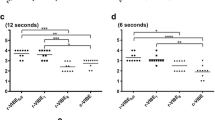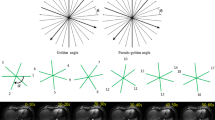Abstract
Objective
To evaluate feasibility of a 3D-isotropic self-gated radial volumetric interpolated breath-hold examination (VIBE) for late-phase MRI of the liver.
Material and methods
70 patients were included and underwent liver MRI at 1.5 T. Depending on the diagnosis, either Gd-EOB-DTPA (35 patients) or gadobutrol (35 patients) were administered. During late (gadobutrol) or hepatocyte-specific phase (Gd-EOB-DTPA), a radial prototype sequence was acquired and reconstructed using (1) self-gating with 40 % acceptance (rVIBE40); (2) with 100 % acceptance of the data (rVIBE100) and compared to Cartesian VIBE (cVIBE). Images were assessed qualitatively (image quality, lesion conspicuity, artefacts; 5-point Likert-scale: 5 = excellent; two independent readers) and quantitatively (coefficient-of-variation (CV); contrast-ratio) in axial and coronal reformations.
Results
In eight cases only rVIBE provided diagnostic image quality. Image quality of rVIBE40 was rated significantly superior (p < 0.05) in Gd-EOB-DTPA-enhanced and coronal reformatted examinations as compared to cVIBE. Lesion conspicuity was significantly improved (p < 0.05) in coronal reformatted Gd-EOB-DTPA-enhanced rVIBE40 in comparison to cVIBE. CV was higher in rVIBE40 as compared to rVIBE100/cVIBE (p < 0.01). Gadobutrol-enhanced rVIBE40 and cVIBE showed higher contrast-ratios than rVIBE100 (p < 0.001), whereas no differences were found in Gd-EOB-DTPA-enhanced examinations.
Conclusion
Self-gated 3D-isotropic rVIBE provides significantly superior image quality compared to cVIBE, especially in multiplanar reformatted and Gd-EOB-DTPA-enhanced examinations.
Key Points
• Radial VIBE acquisition reduces motion artefacts.
• Gd-EOB-DTPA-enhanced scans provide improved image quality.
• Non-diagnostic liver MRI examinations may be reduced by radial k-spaces sampling.





Similar content being viewed by others
References
Elsayes KM, Narra VR, Yin Y, Mukundan G, Lammle M, Brown JJ (2005) Focal hepatic lesions: diagnostic value of enhancement pattern approach with contrast-enhanced 3D gradient-echo MR imaging. Radiographics 25:1299–1320
Rofsky NM, Lee VS, Laub G et al (1999) Abdominal MR imaging with a volumetric interpolated breath-hold examination. Radiology 212:876–884
Hecht EM, Holland AE, Israel GM et al (2006) Hepatocellular carcinoma in the cirrhotic liver: gadolinium-enhanced 3D T1-weighted MR imaging as a stand-alone sequence for diagnosis. Radiology 239:438–447
Wood ML, Henkelman RM (1985) MR image artifacts from periodic motion. Med Phys 12:143–151
Ehman RL, McNamara MT, Brasch RC, Felmlee JP, Gray JE, Higgins CB (1986) Influence of physiologic motion on the appearance of tissue in MR images. Radiology 159:777–782
Chandarana H, Block KT, Winfeld MJ et al (2014) Free-breathing contrast-enhanced T1-weighted gradient-echo imaging with radial k-space sampling for paediatric abdominopelvic MRI. Eur Radiol 24:320–326
Noterdaeme O, Gleeson F, Phillips RR, Brady M (2007) Quantification of missing and overlapping data in multiple breath hold abdominal imaging. Eur J Radiol 64:273–278
Chandarana H, Block TK, Rosenkrantz AB et al (2011) Free-breathing radial 3D fat-suppressed T1-weighted gradient echo sequence: a viable alternative for contrast-enhanced liver imaging in patients unable to suspend respiration. Invest Radiol 46:648–653
Lauterbur PC (1989) Image formation by induced local interactions. Examples employing nuclear magnetic resonance. 1973. Clin Orthop Relat Res 3–6.
Block KT, Chandarana H, Milla S et al (2014) Towards routine clinical use of radial stack-of-stars 3d gradient-echo sequences for reducing motion sensitivity. J Korean Soc Magnet Resonance Med 18:87–106
Chandarana H, Feng L, Block TK et al (2013) Free-breathing contrast-enhanced multiphase MRI of the liver using a combination of compressed sensing, parallel imaging, and golden-angle radial sampling. Invest Radiol 48:10–16
Azevedo RM, de Campos RO, Ramalho M, Heredia V, Dale BM, Semelka RC (2011) Free-breathing 3D T1-weighted gradient-echo sequence with radial data sampling in abdominal MRI: preliminary observations. AJR Am J Roentgenol 197:650–657
Bangiyev L, Raz E, Block TK et al. (2015) Evaluation of the orbit using contrast-enhanced radial 3D fat-suppressed T weighted gradient echo (Radial-VIBE) sequence. Br J Radiol 20140863.
Chandarana H, Heacock L, Rakheja R et al (2013) Pulmonary nodules in patients with primary malignancy: comparison of hybrid PET/MR and PET/CT imaging. Radiology 268:874–881
Shankaranarayanan A, Simonetti OP, Laub G, Lewin JS, Duerk JL (2001) Segmented k-space and real-time cardiac cine MR imaging with radial trajectories. Radiology 221:827–836
Bamrungchart S, Tantaway EM, Midia EC et al (2013) Free breathing three-dimensional gradient echo-sequence with radial data sampling (radial 3D-GRE) examination of the pancreas: Comparison with standard 3D-GRE volumetric interpolated breathhold examination (VIBE). J Magn Reson Imaging 38:1572–1577
Grimm R, Furst S, Souvatzoglou M et al (2015) Self-gated MRI motion modeling for respiratory motion compensation in integrated PET/MRI. Med Image Anal 19:110–120
Furst S, Grimm R, Hong I et al (2015) Motion correction strategies for integrated PET/MR. J Nucl Med 56:261–269
Xiao L, Siu CW, Yeung K, Leung A, Yuen MK, Wong YC (2015) MRI of the cervical spine with 3D gradient echo sequence at 3T: initial experience. Clin Radiol 70:926–931
Gustas CN, Blankenbaker DG, Rio AM, Winalski CS, Kijowski R (2015) Evaluation of the Articular Cartilage of the Knee Joint Using an Isotropic Resolution 3D Fast Spin-Echo Sequence With Conventional and Radial Reformatted Images. AJR Am J Roentgenol 205:371–379
AlObaidy M, Ramalho M, Busireddy KK et al (2015) High-resolution 3D-GRE imaging of the abdomen using controlled aliasing acceleration technique - a feasibility study. Eur Radiol
Notohamiprodjo M, Kuschel B, Horng A et al (2012) 3D-MRI of the ankle with optimized 3D-SPACE. Invest Radiol 47:231–239
van Elmpt W, Hamill J, Jones J, De Ruysscher D, Lambin P, Ollers M (2011) Optimal gating compared to 3D and 4D PET reconstruction for characterization of lung tumours. Eur J Nucl Med Mol Imaging 38:843–855
Dietrich O, Raya JG, Reeder SB, Reiser MF, Schoenberg SO (2007) Measurement of signal-to-noise ratios in MR images: influence of multichannel coils, parallel imaging, and reconstruction filters. J Magn Reson Imaging 26:375–385
Reiner CS, Neville AM, Nazeer HK et al (2013) Contrast-enhanced free-breathing 3D T1-weighted gradient-echo sequence for hepatobiliary MRI in patients with breath-holding difficulties. Eur Radiol 23:3087–3093
Rosenkrantz AB, Block TK, Hindman N, Vega E, Chandarana H (2014) Combination of increased flip angle, radial k-space trajectory, and free breathing acquisition for improved detection of a biliary variant at living donor liver transplant evaluation using gadoxetic acid-enhanced MRCP. J Comput Assist Tomogr 38:277–280
Chandarana H, Feng L, Ream J et al (2015) Respiratory Motion-Resolved Compressed Sensing Reconstruction of Free-Breathing Radial Acquisition for Dynamic Liver Magnetic Resonance Imaging. Invest Radiol
Xue Y, Yu J, Kang HS, Englander S, Rosen MA, Song HK (2012) Automatic coil selection for streak artifact reduction in radial MRI. Magn Reson Med 67:470–476
Schultz CL, Alfidi RJ, Nelson AD, Kopiwoda SY, Clampitt ME (1984) The effect of motion on two-dimensional Fourier transformation magnetic resonance images. Radiology 152:117–121
Zech CJ, Grazioli L, Breuer J, Reiser MF, Schoenberg SO (2008) Diagnostic performance and description of morphological features of focal nodular hyperplasia in Gd-EOB-DTPA-enhanced liver magnetic resonance imaging: results of a multicenter trial. Invest Radiol 43:504–511
Kwon HJ, Byun JH, Kim JY et al (2015) Differentiation of small (</=2cm) hepatocellular carcinomas from small benign nodules in cirrhotic liver on gadoxetic acid-enhanced and diffusion-weighted magnetic resonance images. Abdom Imaging 40:64–75
Choi JW, Lee JM, Kim SJ et al (2013) Hepatocellular carcinoma: imaging patterns on gadoxetic acid-enhanced MR Images and their value as an imaging biomarker. Radiology 267:776–786
Park HJ, Jang KM, Kang TW et al (2015) Identification of Imaging Predictors Discriminating Different Primary Liver Tumours in Patients with Chronic Liver Disease on Gadoxetic Acid-enhanced MRI: a Classification Tree Analysis. Eur Radiol. doi:10.1007/s00330-015-4136-y
Kim YS, Song JS, Lee HK, Han YM (2015) Hypovascular hypointense nodules on hepatobiliary phase without T2 hyperintensity on gadoxetic acid-enhanced MR images in patients with chronic liver disease: long-term outcomes and risk factors for hypervascular transformation. Eur Radiol. doi:10.1007/s00330-015-4146-9
Quillin SP, Atilla S, Brown JJ, Borrello JA, Yu CY, Pilgram TK (1997) Characterization of focal hepatic masses by dynamic contrast-enhanced MR imaging: findings in 311 lesions. Magn Reson Imaging 15:275–285
Fujinaga Y, Ohya A, Tokoro H et al (2014) Radial volumetric imaging breath-hold examination (VIBE) with k-space weighted image contrast (KWIC) for dynamic gadoxetic acid (Gd-EOB-DTPA)-enhanced MRI of the liver: advantages over Cartesian VIBE in the arterial phase. Eur Radiol 24:1290–1299
Fujinaga Y, Kitou Y, Ohya A et al (2015) Advantages of radial volumetric breath-hold examination (VIBE) with k-space weighted image contrast reconstruction (KWIC) over Cartesian VIBE in liver imaging of volunteers simulating inadequate or no breath-holding ability. Eur Radiol. doi:10.1007/s00330-015-4103-7
Acknowledgments
The scientific guarantor of this publication is Mike Notohamiprodjo. The authors of this manuscript declare relationships with the following companies: Robert Grimm is an employee of Siemens Healthcare and was involved in the development of the self-gating algorithm. The authors state that this work has not received any funding. No complex statistical methods were necessary for this paper.
Institutional Review Board approval was obtained. Written informed consent was waived by the Institutional Review Board. Methodology: retrospective, performed at one institution.
Author information
Authors and Affiliations
Corresponding author
Rights and permissions
About this article
Cite this article
Weiss, J., Taron, J., Othman, A.E. et al. Feasibility of self-gated isotropic radial late-phase MR imaging of the liver. Eur Radiol 27, 985–994 (2017). https://doi.org/10.1007/s00330-016-4433-0
Received:
Revised:
Accepted:
Published:
Issue Date:
DOI: https://doi.org/10.1007/s00330-016-4433-0




